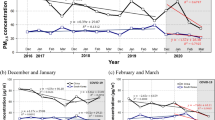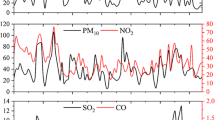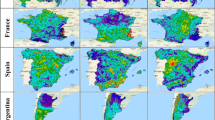Abstract
To mitigate the societal impact of the COVID-19 pandemic, China implemented long-term restrictive measures. The sudden liberalization at the end of 2022 disrupted residents’ daily routines, making it scientifically intriguing to explore its effect on air quality. Taking Chongqing City in Southwest China as an example, we examined the impact of restriction liberalization on air quality, identified potential sources of pollutants, simulated the effects of abrupt anthropogenic control relaxation using a Random Forest Model, and applied an optimized model to predict the post-liberalization pollutant concentrations. The results showed increases in PM2.5 (72.3%), PM10 (67.7%), and NO2 (21.9%) concentrations, while O3 concentration decreased by 20.5%. Although potential pollution source areas contracted, pollution levels intensified with northeastern Sichuan, interior Chongqing, and northern Guizhou being major contributors to pollutant emissions. Anthropogenic emissions accounted for 26.7 ~ 33% changes in PM2.5 and PM10 concentrations while meteorological conditions contributed to 40.2 ~ 43.3% variations observed during the period. The optimized model demonstrated a correlation between predicted and observed values with R2 ranging from 0.70 to 0.89, enabling accurate prediction of post-liberalization pollutant concentrations. This study can enhance our understanding regarding the impact of sudden social lockdown relaxation events on air quality while providing support for urban air pollution prevention.







Similar content being viewed by others

Explore related subjects
Discover the latest articles and news from researchers in related subjects, suggested using machine learning.Data availability
No datasets were generated or analysed during the current study.
References
Asmel, N. K., Muhammed, F. I., Hassan, S. I., et al. (2022). Assessment of ambient air quality in urban places of Mosul City, Iraq. International Journal of Environmental Science and Technology [j], 20, 3247–3264. https://doi.org/10.1007/s13762-022-04197-6
Bhatti, U. A., Zeeshan, Z., Nizamani, M. M., et al. (2022). Assessing the change of ambient air quality patterns in Jiangsu Province of China pre-to post-COVID-19. Chemosphere [j], 288, 132569. https://doi.org/10.1016/j.chemosphere.2021.132569
Bilal, M., Hassan, M., Tahir, D. B. T., et al. (2022). Understanding the role of atmospheric circulations and dispersion of air pollution associated with extreme smog events over South Asian megacity. Environmental Monitoring and Assessment [J], 194. https://doi.org/10.1007/s10661-021-09674-y
Breiding, P., Sottile, F., & Woodcock, J. (2021). Euclidean distance degree and mixed volume. Foundations of Computational Mathematics [j], 22, 1743–1765. https://doi.org/10.1007/s10208-021-09534-8
Breiman, L. (2001). Random forests. Machine Learning [j], 45, 5–32. https://doi.org/10.1023/A:1010933404324
Cardito, A., Carotenuto, M., Amoruso, A., et al. (2023). Air quality trends and implications pre and post COVID-19 restrictions. Science of the Total Environment [j], 879, 162833. https://doi.org/10.1016/j.scitotenv.2023.162833
Chen, K., Wang, M., Huang, C., et al. (2020). Air pollution reduction and mortality benefit during the COVID-19 outbreak in China. Lancet Planet Health [j], 4, e210–e212. https://doi.org/10.1016/S2542-5196(20)30107-8
Chen, Y., & Xie, S. (2017). Temporal and spatial visibility trends in the Sichuan Basin, China, 1973 to 2010. Atmospheric Research [j], 112, 25–34. https://doi.org/10.1016/j.atmosres.2012.04.009
Crabot, J., Clappe, S., Dray, S., et al. (2019). Testing the Mantel statistic with a spatially-constrained permutation procedure. Methods in Ecology and Evolution [j], 10, 532–540. https://doi.org/10.1111/2041-210x.13141
Donzelli, G., Cioni, L., Cancellieri, M., et al. (2020). The effect of the COVID-19 lockdown on air quality in three Italian medium-sized cities. Atmosphere [J], 11. https://doi.org/10.3390/atmos11101118
Fan, Z., Zhan, Q., Yang, C., et al. (2020). Estimating PM2.5 concentrations using spatially local Xgboost based on full-covered SARA AOD at the urban scale. Remote Sensing [J], 12. https://doi.org/10.3390/rs12203368
Gao, B., Ouyang, W., Cheng, H., et al. (2019). Interactions between rainfall and fine particulate matter investigated by simultaneous chemical composition measurements in downtown Beijing. Atmospheric Environment [J], 218. https://doi.org/10.1016/j.atmosenv.2019.117000.
Grange, S. K., & Carslaw, D. C. (2019). Using meteorological normalisation to detect interventions in air quality time series. Science of the Total Environment [j], 653, 578–588. https://doi.org/10.1016/j.scitotenv.2018.10.344
Grange, S. K., Carslaw, D. C., Lewis, A. C., et al. (2018). Random forest meteorological normalisation models for Swiss PM10 trend analysis. Atmospheric Chemistry and Physics [j], 18, 6223–6239. https://doi.org/10.5194/acp-18-6223-2018
Gui, K., Che, H., Zeng, Z., et al. (2020). Construction of a virtual PM2.5 observation network in China based on high-density surface meteorological observations using the extreme gradient boosting model. Environment International [J], 141, 105801. https://doi.org/10.1016/j.envint.2020.105801
He, J., Gong, S., Yu, Y., et al. (2017). Air pollution characteristics and their relation to meteorological conditions during 2014–2015 in major Chinese cities. Environmental Pollution, 223, 484–496. https://doi.org/10.1016/j.envpol.2017.01.050
Hu, J., Pan, Y., He, Y., et al. (2021). Changes in air pollutants during the COVID-19 lockdown in Beijing: Insights from a machine-learning technique and implications for future control policy. Atmospheric and Oceanic Science Letters [J], 14. https://doi.org/10.1016/j.aosl.2021.100060.
Huang, L., Sun, J., Jin, L., et al. (2021). Strategies to reduce PM2.5 and O3 together during late summer and early fall in San Joaquin Valley, California. Atmospheric Research [J], 258. https://doi.org/10.1016/j.atmosres.2021.105633
Jin, X., & Holloway, T. (2015). Spatial and temporal variability of ozone sensitivity over China observed from the ozone monitoring instrument. Journal of Geophysical Research: Atmospheres [j], 120, 7229–7246. https://doi.org/10.1002/2015jd023250
Le, T., Wang, Y., Liu, L., et al. (2023). Unexpected air pollution with marked emission reductions during the COVID-19 outbreak in China. Science [J], 702. https://doi.org/10.1126/science.abb7431.
Li, L., Mao, Z., Du, J., et al. (2022). The impact of COVID-19 control measures on air quality in Guangdong Province. Sustainability [J], 14. https://doi.org/10.3390/su14137853.
Li, L., Li, Q., Huang, L., et al. (2020). Air quality changes during the COVID-19 lockdown over the Yangtze River Delta region: An insight into the impact of human activity pattern changes on air pollution variation. Sci Total Environ [j], 732, 139282. https://doi.org/10.1016/j.scitotenv.2020.139282
Lv, Y., Tian, H., Luo, L., et al. (2023). Understanding and revealing the intrinsic impacts of the COVID-19 lockdown on air quality and public health in North China using machine learning. Sci Total Environ [j], 857, 159339. https://doi.org/10.1016/j.scitotenv.2022.159339
Masood, A., & Ahmad, K. (2021). A review on emerging artificial intelligence (AI) techniques for air pollution forecasting: Fundamentals, application and performance. Journal of Cleaner Production [J], 322. https://doi.org/10.1016/j.jclepro.2021.129072
Peng, J., Han, H., Yi, Y., et al. (2022). Machine learning and deep learning modeling and simulation for predicting PM25 concentrations. Chemosphere [J], 308, 136353. https://doi.org/10.1016/j.chemosphere.2022.136353
Porter, W. C., & Heald, C. L. (2019). The mechanisms and meteorological drivers of the summertime ozone–temperature relationship. Atmospheric Chemistry and Physics [j], 19, 13367–13381. https://doi.org/10.5194/acp-19-13367-2019
Reiminger, N., Jurado, X., Vazquez, J., et al. (2020). Methodologies to assess mean annual air pollution concentration combining numerical results and wind roses. Sustainable Cities and Society [J], 59. https://doi.org/10.1016/j.scs.2020.102221
Ren, Y., Guan, X., Zhang, Q., et al. (2023). A machine learning-based study on the impact of COVID-19 on three kinds of pollution in Beijing-Tianjin-Hebei region. Sci Total Environ [j], 884, 163190. https://doi.org/10.1016/j.scitotenv.2023.163190
Shan, M., Wang, Y., Lu, Y., et al. (2023). Uncovering PM2.5 transport trajectories and sources at district within city scale. Journal of Cleaner Production [J], 423. https://doi.org/10.1016/j.jclepro.2023.138608
Sulaymon, I. D., Zhang, Y., Hopke, P. K., et al. (2021). COVID-19 pandemic in Wuhan: Ambient air quality and the relationships between criteria air pollutants and meteorological variables before, during, and after lockdown. Atmos Res [j], 250, 105362. https://doi.org/10.1016/j.atmosres.2020.105362
Thomas, G., Thomas, J., Devika, R. S., et al. (2023). Impact of COVID-19 lockdown on ambient air quality in the southwest coastal urban regions of india. Aerosol Science and Engineering [J], 7(3), 303–314. https://doi.org/10.1007/s41810-023-00180-x
von Schneidemesser, E., Steinmar, K., Weatherhead, E. C., et al. (2019). Air pollution at human scales in an urban environment: Impact of local environment and vehicles on particle number concentrations. Science of The Total Environment, 688, 691–700. https://doi.org/10.1016/j.scitotenv.2019.06.309
Wang, Y. Q. (2014). MeteoInfo: GIS software for meteorological data visualization and analysis. Meteorological Applications [j], 21, 360–368. https://doi.org/10.1002/met.1345
Wang, Y., Wen, Y., Wang, Y., et al. (2020). Four-month changes in air quality during and after the COVID-19 lockdown in six megacities in China. Environmental Science & Technology Letters [j], 7, 802–808. https://doi.org/10.1021/acs.estlett.0c00605
Wang, Y. Q., Zhang, X. Y., & Draxler, R. R. (2009). TrajStat: GIS-based software that uses various trajectory statistical analysis methods to identify potential sources from long-term air pollution measurement data. Environmental Modelling & Software [j], 24, 938–939. https://doi.org/10.1016/j.envsoft.2009.01.004
Wright, M. N., & Ziegler, A. (2017). Ranger: A fast implementation of random forests for high dimensional data in C++ and R. Journal of Statistical Software [J], 77. https://doi.org/10.18637/jss.v077.i01
Xiao, K., Yao, X., Ren, X., et al. (2023). Transmission characteristics, source apportionment and health risk assessment of PM2.5 in a typical industrial city in Northwest China. Urban Climate [J], 47, 101367. https://doi.org/10.1016/j.uclim.2022.101367
Yang, C., Zeng, W., Yang, X., et al. (2020). Coupling coordination evaluation and sustainable development pattern of geo-ecological environment and urbanization in Chongqing municipality, China. Sustainable Cities and Society [J], 61. https://doi.org/10.1016/j.scs.2020.102271
Zhang, Q., Zhang, Q., Liu, H., et al. (2023b). The impact of COVID-19 lockdown on ambient air quality in Shanghai, 2022. Atmosphere [J], 14. https://doi.org/10.3390/atmos14050898
Zhang, B., Zhang, Y., Zhang, K., et al. (2023a). Machine learning assesses drivers of PM(2.5) air pollution trend in the Tibetan Plateau from 2015 to 2022. Sci Total Environ [J], 878, 163189. https://doi.org/10.1016/j.scitotenv.2023.163189
Zhang, H., Lin, Y., Wei, S., et al. (2021). Global association between satellite-derived nitrogen dioxide (NO(2)) and lockdown policies under the COVID-19 pandemic. Sci Total Environ [j], 761, 144148. https://doi.org/10.1016/j.scitotenv.2020.144148
Zhang, R., Li, Y., Zhang, A. L., et al. (2020). Identifying airborne transmission as the dominant route for the spread of COVID-19. Proceedings of the National Academy of Sciences U S A [j], 117, 14857–14863. https://doi.org/10.1073/pnas.2009637117
Zhang, R., Wang, Y., Smeltzer, C., et al. (2018). Comparing OMI-based and EPA AQS in situ NO2 trends: Towards understanding surface NOx emission changes. Atmospheric Measurement Techniques [j], 11, 3955–3967. https://doi.org/10.5194/amt-11-3955-2018
Zhao, S., Yu, Y., Yin, D., et al. (2018). Spatial patterns and temporal variations of six criteria air pollutants during 2015 to 2017 in the city clusters of Sichuan Basin, China. Sci Total Environ [j], 624, 540–557. https://doi.org/10.1016/j.scitotenv.2017.12.172
Zhou, S., Liu, N., & Liu, C. (2017). Identification for potential sources for haze events in Shanghai from 2013 to 2015. Acta Scientiae Circumstantiae [J], 37(1835–1842), 1. https://doi.org/10.13671/j.hjkxxb.2016.0356
Funding
This work was funded by the Science and Technology Commission of Chongqing project (No. CSTB2022NSCQ‐MSX0818) and the Wanzhou project (wzstc-20220303).
Author information
Authors and Affiliations
Contributions
Haozheng Wang: Writing—original draft, Data Curation. Liuyi Zhang: Writing—review & editing, Review. Yuanjun Chen: Resources. Guangming Shi: Review & Revise, Supervision. Chentao Huang: Validation. Fumo Yang: Review, Supervision, Resources. Weihao Li: Investigation.
Corresponding authors
Ethics declarations
Ethics approval and consent to participate
Not applicable.
Consent for publication
Not applicable.
Competing interests
The authors declare no competing interests.
Additional information
Publisher's Note
Springer Nature remains neutral with regard to jurisdictional claims in published maps and institutional affiliations.
Supplementary Information
Below is the link to the electronic supplementary material.
Rights and permissions
Springer Nature or its licensor (e.g. a society or other partner) holds exclusive rights to this article under a publishing agreement with the author(s) or other rightsholder(s); author self-archiving of the accepted manuscript version of this article is solely governed by the terms of such publishing agreement and applicable law.
About this article
Cite this article
Wang, H., Zhang, L., Chen, Y. et al. Impact of COVID-19 restrictions liberalization on air quality: a case study of Chongqing, Southwest China. Environ Monit Assess 196, 1111 (2024). https://doi.org/10.1007/s10661-024-13213-w
Received:
Accepted:
Published:
DOI: https://doi.org/10.1007/s10661-024-13213-w



